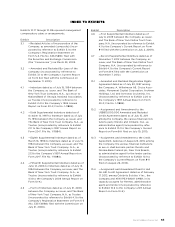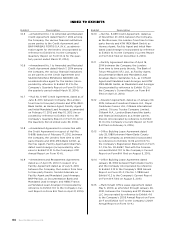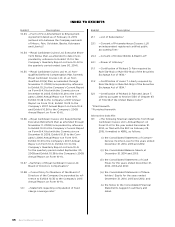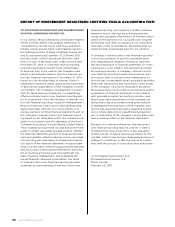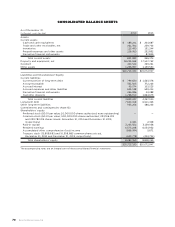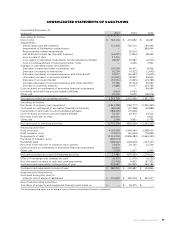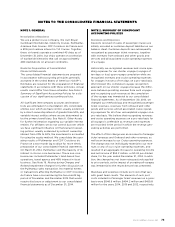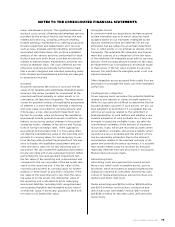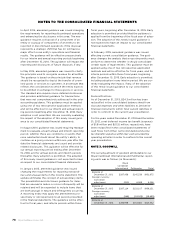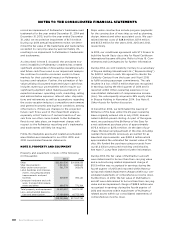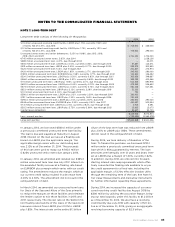Royal Caribbean Cruise Lines 2014 Annual Report Download - page 74
Download and view the complete annual report
Please find page 74 of the 2014 Royal Caribbean Cruise Lines annual report below. You can navigate through the pages in the report by either clicking on the pages listed below, or by using the keyword search tool below to find specific information within the annual report.
Royal Caribbean Cruises Ltd. 73
NOTES TO THE CONSOLIDATED FINANCIAL STATEMENTS
NOTE 1. GENERAL
Description of Business
We are a global cruise company. We own Royal
Caribbean International, Celebrity Cruises, Pullmantur,
Azamara Club Cruises, CDF Croisières de France and
a 50% joint venture interest in TUI Cruises. Together,
these six brands operate a combined 43 ships as of
December 31, 2014. Our ships operate on a selection
of worldwide itineraries that call on approximately
480 destinations on all seven continents.
Basis for Preparation of Consolidated
Financial Statements
The consolidated financial statements are prepared
in accordance with accounting principles generally
accepted in the United States of America (“GAAP”).
Estimates are required for the preparation of financial
statements in accordance with these principles. Actual
results could differ from these estimates. See Note 2.
Summary of Significant Accounting Policies for a dis-
cussion of our significant accounting policies.
All significant intercompany accounts and transac-
tions are eliminated in consolidation. We consolidate
entities over which we have control, usually evidenced
by a direct ownership interest of greater than 50%, and
variable interest entities where we are determined to
be the primary beneficiary. See Note 6. Other Assets
for further information regarding our variable interest
entities. For affiliates we do not control but over which
we have significant influence on financial and operat-
ing policies, usually evidenced by a direct ownership
interest from 20% to 50%, the investment is accounted
for using the equity method. We consolidate the oper-
ating results of Pullmantur and CDF Croisières de
France on a two-month lag to allow for more timely
preparation of our consolidated financial statements.
On March 31, 2014, Pullmantur sold the majority of its
interest in its non-core businesses. These non-core
businesses included Pullmantur’s land-based tour
operations, travel agency and 49% interest in its air
business. See Note 16. Restructuring Charges and
Related Impairment Charges for further discussion on
the Pullmantur sales transaction. No material events
or transactions affecting Pullmantur or CDF Croisières
de France have occurred during the two-month lag
period of November and December 2014 that would
require disclosure or adjustment to our consolidated
financial statements as of December 31, 2014.
NOTE 2. SUMMARY OF SIGNIFICANT
ACCOUNTING POLICIES
Revenues and Expenses
Deposits received on sales of passenger cruises are
initially recorded as customer deposit liabilities on our
balance sheet. Customer deposits are subsequently
recognized as passenger ticket revenues, together
with revenues from onboard and other goods and
services and all associated cruise operating expenses
of a voyage.
Historically, we recognized revenues and cruise oper-
ating expenses for our shorter voyages (voyages of
ten days or less) upon voyage completion while we
recognized revenues and cruise operating expenses
for voyages in excess of ten days on a pro-rata basis.
We followed this completed voyage recognition
approach on our shorter voyages because the differ-
ence between prorating revenue from such voyages
and recognizing such revenue at the completion
of the voyage was immaterial to our consolidated
financial statements. As of September 30, 2014, we
changed our methodology and recognized passenger
ticket revenues, revenues from onboard and other
goods and services and all associated cruise operat-
ing expenses for all of our uncompleted voyages on a
pro-rata basis. We believe that recognizing revenues
and cruise operating expenses on a pro-rata basis for
all voyages is preferable as revenues and expenses
are recorded in the period in which the revenue gen-
erating activities are performed.
The effect of this change was an increase to Passenger
ticket revenues and Onboard and other revenues, as
well as an increase to our Cruise operating expenses.
The change was not individually material to our reve-
nues or any of our cruise operating expenses, and
resulted in an aggregate increase to operating income
and net income of $53.2 million, or $0.24 per diluted
share, for the year ended December 31, 2014. In addi-
tion, the change has not been retrospectively applied
to prior periods, as the impact of prorating all voyages
was immaterial to the respective periods presented.
Revenues and expenses include port costs that vary
with guest head counts. The amounts of such port
costs included in Passenger ticket revenues on a gross
basis were $546.6 million, $494.2 million and $459.8
million for the years 2014, 2013 and 2012, respectively.


